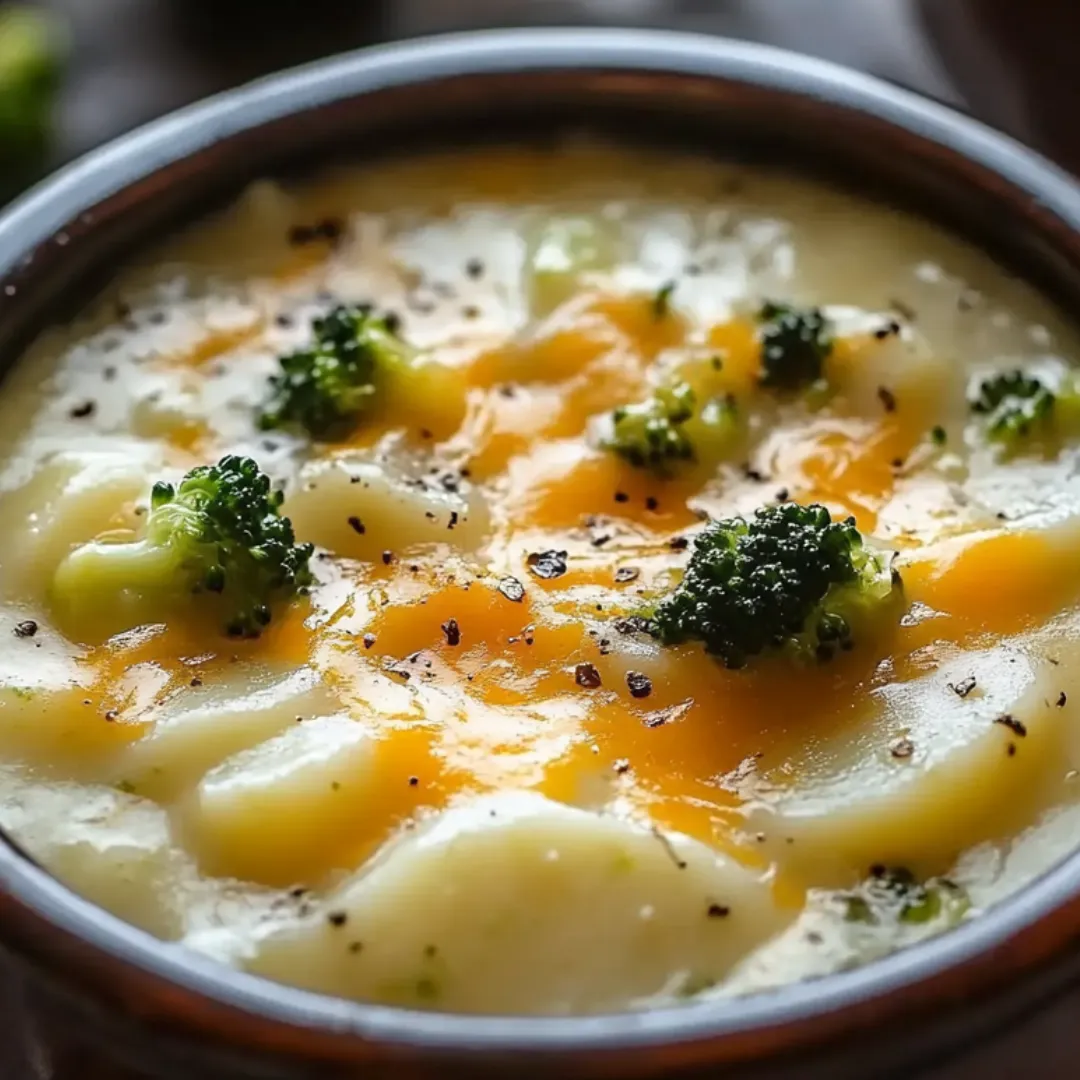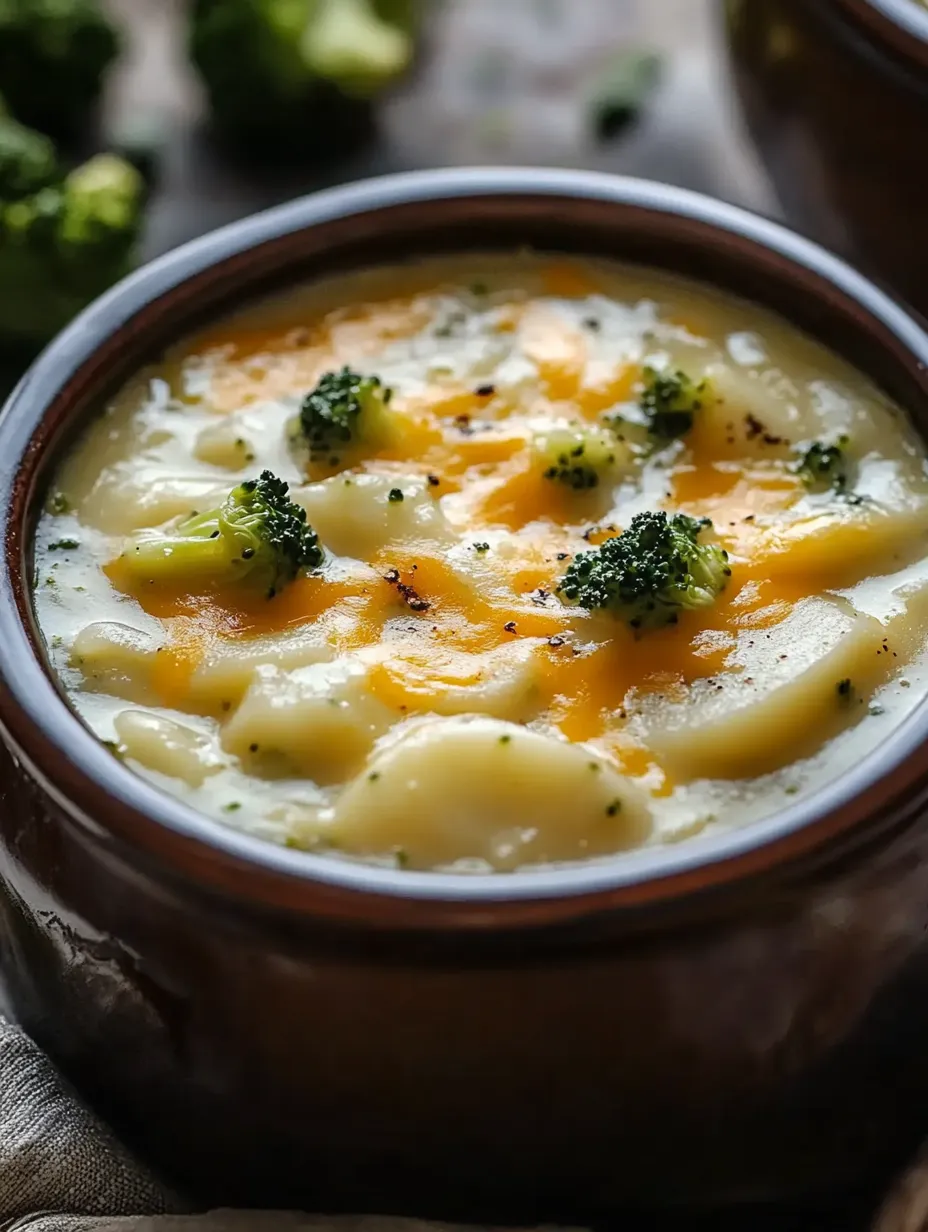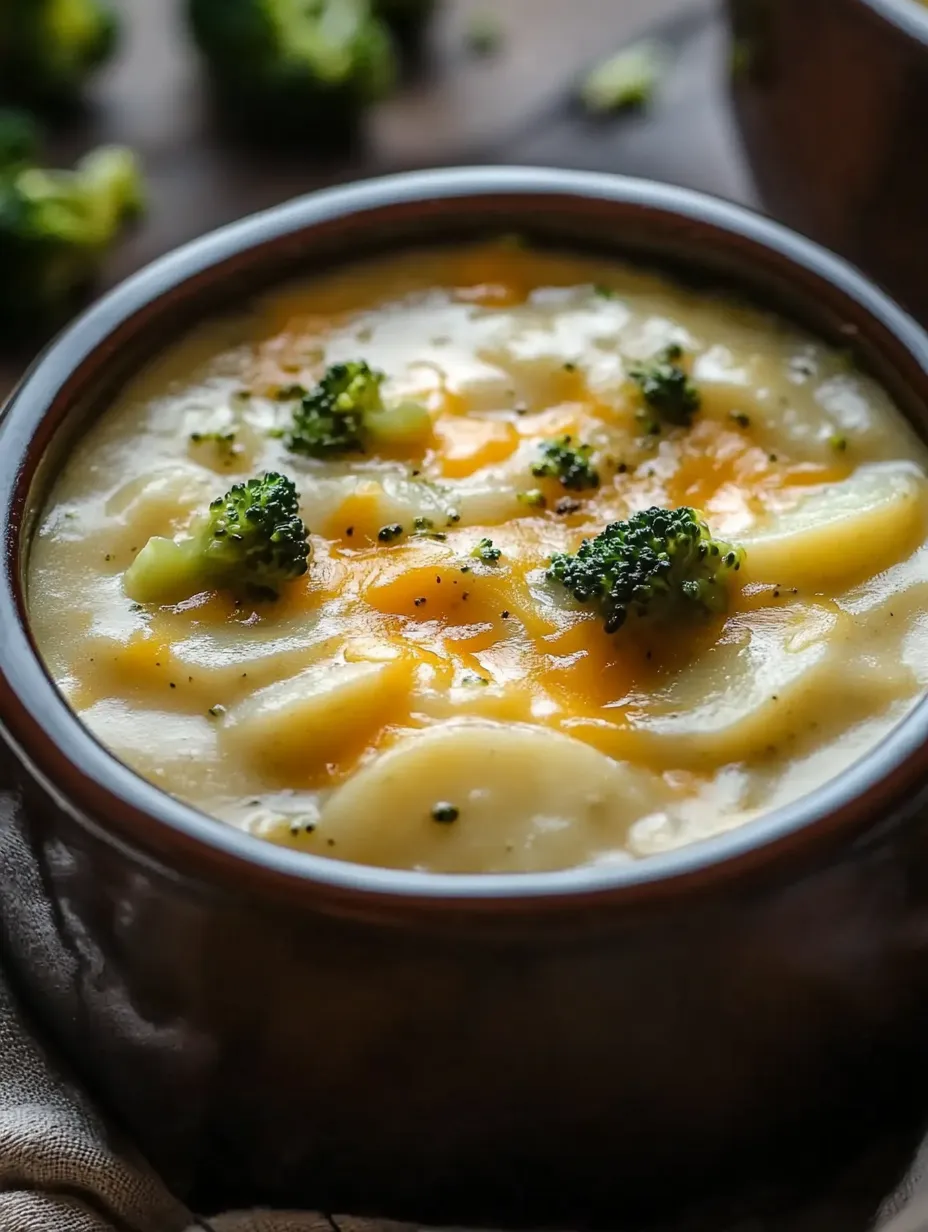 Pin it
Pin it
This velvety Crockpot Potato Broccoli Cheddar Soup marries the hearty satisfaction of loaded baked potatoes with the creamy comfort of broccoli cheese soup. The slow cooking process allows the flavors to meld beautifully while keeping your hands free for other tasks. Tender chunks of potato provide substance and naturally thicken the broth, while fresh broccoli florets add color, texture, and nutrition. The finishing touch of real, freshly grated cheddar creates a rich, cheesy experience that processed ingredients simply can't match.
The first time I made this soup was during a particularly brutal winter storm that had us snowed in for days. With limited pantry options but a refrigerator full of vegetables and dairy that needed using, this recipe was born out of necessity. The incredible aroma that filled our home throughout the day became an unexpected silver lining to our cabin fever. My typically soup-resistant teenager wandered into the kitchen repeatedly, asking when dinner would be ready. By the time we finally sat down to eat, everyone was nearly climbing into the crockpot! Now, whenever the forecast predicts snow, my family immediately requests this soup, creating a warm tradition from what started as a simple solution to a storm-day dilemma.
Ingredients
- 2 pounds Yukon Gold potatoes: These golden-fleshed potatoes create the perfect creamy base for the soup. Their waxy texture helps them hold shape while still breaking down enough to thicken the broth naturally. Choose firm potatoes with smooth skin and no green spots or sprouts. Peel them completely and cut into even ¾-inch cubes for consistent cooking. The uniform size ensures they'll reach that perfect tender stage simultaneously.
- 4 cups fresh broccoli florets: Provide vibrant color, texture contrast, and nutritional value. Select broccoli heads with tight, dark green florets and firm stems without yellowing. Cut them into bite-sized pieces that will fit comfortably on a spoon. Fresh broccoli maintains better texture during slow cooking than frozen, though frozen can work in a pinch if added later in the cooking process.
- 1 large yellow onion: Creates an aromatic foundation that deepens the overall flavor profile. Look for firm onions with dry, crackly outer skin and no soft spots. Dice into small, even pieces (about ¼-inch) to ensure they melt into the background of the soup rather than standing out as noticeable chunks. Yellow onions provide the perfect balance of sweetness and savory notes when cooked slowly.
- 2 carrots: Add natural sweetness, beautiful color, and nutritional benefits. Choose firm, bright orange carrots without cracks. Peel thoroughly and dice into small pieces similar in size to the onion. The carrots will soften considerably during cooking but maintain enough structure to add textural interest and visual appeal to the finished soup.
- 2 celery stalks: Contribute an earthy depth and subtle savory note that rounds out the flavor base. Select crisp, pale green stalks without blemishes or limpness. Remove any strings by peeling the outer layer if necessary, then dice to match the size of your other aromatics. The celery becomes quite soft during cooking, nearly disappearing while leaving its distinctive flavor behind.
- 4 cloves garlic: Provide essential aromatic depth that complements the rich dairy elements. Choose firm garlic cloves without green sprouts in the center, which can add bitterness. Mince finely to ensure the flavor distributes evenly throughout the soup. Fresh garlic dramatically outperforms pre-minced varieties in developing complex flavor during the long cooking process.
- 6 cups chicken broth: Forms the liquid foundation that transforms into a silky soup. Homemade stock offers the richest flavor, but high-quality store-bought broth works beautifully. Low-sodium varieties allow better control over the soup's final seasoning. The broth should be just enough to barely cover the vegetables, creating a concentrated base that will be enriched with cream later.
- 2 cups heavy cream: Creates the luxurious, velvety texture that defines this soup. Look for cream with a high fat content (at least 36%) for the smoothest result that won't curdle during cooking. The cream should be fresh and carrageenan-free if possible, as this additive can sometimes create an unusual texture when heated for extended periods.
- 3 cups sharp cheddar cheese: Delivers the distinctive cheesy flavor that makes this soup irresistible. Choose a good-quality aged cheddar with pronounced flavor—the sharper the better for maximum impact. Always grate fresh from a block rather than using pre-shredded varieties, which contain anti-caking agents that prevent proper melting and can create a grainy texture in the finished soup.
- 2 teaspoons dried thyme: Adds a subtle herbal note that complements both the vegetables and dairy elements. The dried version works better than fresh in slow cooker recipes, as it releases its flavor gradually throughout the long cooking time. Crush the dried leaves lightly between your fingers before adding to release their aromatic oils.
- 1 teaspoon garlic powder: Provides a different dimension of garlic flavor that complements the fresh garlic. Look for garlic powder without added salt or preservatives for the purest flavor. This ingredient helps create depth by offering both the bright notes of fresh garlic and the mellower, more rounded flavor of dried garlic.
- Kosher salt and fresh cracked pepper: Essential for bringing all the flavors into focus. Diamond Crystal kosher salt is ideal for its clean taste and ease of control when seasoning. Freshly cracked black pepper offers significantly more aromatic notes than pre-ground, making a noticeable difference in the finished soup. Season conservatively during cooking and adjust at the end, as the cheese will add significant saltiness.
 Pin it
Pin it
Step-by-Step Instructions
- Step 1: Prepare the vegetables with precision
- Begin by thoroughly washing all your vegetables under cool running water to remove any dirt or residue. Using a sharp knife and stable cutting board, peel the Yukon Gold potatoes completely, removing any eyes or blemishes you encounter. Cut them into uniform ¾-inch cubes, maintaining consistent size for even cooking. Next, prepare your aromatic base: peel and dice the yellow onion into small pieces about ¼-inch in size; trim the ends from your carrots, peel them thoroughly, and dice to match the size of your onion; remove any tough strings from the celery stalks by running a vegetable peeler lightly down their length, then dice to the same size as your other aromatics. Peel the garlic cloves and mince them finely. Set the broccoli aside for now—it will be added later in the cooking process to preserve its color and texture. Taking time for precise cutting now ensures a perfectly textured soup later.
- Step 2: Layer ingredients thoughtfully in the slow cooker
- Take your slow cooker insert and ensure it's clean and dry. There's no need to preheat it. Begin by adding the diced potatoes as the bottom layer—they'll need the longest cooking time to become perfectly tender. Next, add your aromatic mixture of diced onions, carrots, and celery, distributing them evenly over the potatoes. Sprinkle the minced garlic across the vegetables, followed by the dried thyme and garlic powder. Season with a moderate amount of kosher salt and freshly cracked black pepper, keeping in mind that you'll add more seasoning at the end if needed. The layering approach ensures the vegetables that need the most cooking time are positioned where the heat concentration is highest.
- Step 3: Add broth and set cooking parameters
- Pour the chicken broth over your vegetable layers, adding just enough to barely cover the ingredients—approximately 6 cups, though you may need slightly more or less depending on your slow cooker's size and shape. The broth should just reach the top of the vegetables without completely submerging them, as the vegetables will release moisture during cooking. Secure the lid firmly on your slow cooker and set the temperature according to your timeline: LOW for 6-7 hours if you have the luxury of time, which develops slightly more flavor, or HIGH for 3-4 hours if you're on a tighter schedule. Both methods will yield delicious results, but the longer, slower method allows for more complete flavor development and a slightly silkier texture.
- Step 4: Add broccoli at the perfect moment
- When your slow cooker has approximately one hour of cooking time remaining (so after 5-6 hours on LOW or 2-3 hours on HIGH), prepare your broccoli. Cut the florets into bite-sized pieces that will fit comfortably on a spoon, removing any tough stems. Quickly lift the slow cooker lid—be careful of the escaping steam!—and gently stir in the broccoli florets, submerging them in the hot liquid. Replace the lid immediately to minimize heat loss. This timing is crucial: adding the broccoli too early would cause it to overcook and lose its vibrant color and texture, while adding it too late would leave it unpleasantly crunchy. This one-hour cooking period perfectly balances tenderness while maintaining the broccoli's bright green color and nutritional value.
- Step 5: Transform the soup with dairy enrichments
- During the final 30 minutes of cooking time, prepare to add the dairy components that will transform the soup from a simple vegetable broth to a luxurious, creamy masterpiece. First, carefully remove the lid and lower the slow cooker temperature to LOW if it was previously set to HIGH. Pour in the heavy cream in a slow, steady stream while gently stirring to incorporate it completely without splashing. The cream should immediately begin to take on color from the broth, creating a beautiful golden base. Replace the lid and allow the soup to continue cooking for about 15 minutes, allowing the cream to heat through completely.
- Step 6: Add cheese with proper technique
- After the cream has heated through, it's time for the final transformation. Take your freshly grated cheddar cheese and add it to the soup in three separate batches, rather than all at once. Sprinkle about one-third of the cheese over the surface of the soup, then gently stir until it's completely melted and incorporated before adding the next batch. This gradual addition prevents the cheese from clumping and ensures a smooth, velvety texture. The soup will visibly thicken and become more glossy with each addition of cheese. Once all the cheese has been incorporated, let the soup continue cooking for the remaining few minutes with the lid off, stirring occasionally.
- Step 7: Final seasoning adjustments
- With all ingredients now incorporated, it's time for the crucial final seasoning. Take a clean spoon and taste the soup carefully, considering its flavor profile. Add additional kosher salt and freshly ground black pepper as needed, keeping in mind that the cheese has added considerable saltiness already. If the soup tastes flat, it likely needs more salt to bring the flavors into focus. A few extra cracks of black pepper can add dimension without dominating. Stir gently after each small addition of seasoning, then taste again before making further adjustments. This methodical approach ensures perfect flavor balance without over-seasoning.
- Step 8: Serve with appropriate garnishes
- Once the soup has reached the perfect flavor balance and all ingredients are fully incorporated, it's ready to serve. Ladle the hot soup into warmed bowls—running them under hot water and drying them quickly before filling creates the best serving temperature. Top each portion with a small handful of additional freshly grated cheddar cheese, which will melt beautifully over the hot surface. Add a sprinkle of finely chopped chives or sliced green onions for a fresh, colorful contrast that complements the rich soup. For textural interest, offer crispy homemade croutons or oyster crackers on the side. Serve immediately while the soup is at its peak temperature and consistency.
The Perfect Cold-Weather Comfort
There's something particularly magical about arriving home on a blustery winter day to the aroma of this soup that has been slowly simmering while you were away. The combination of savory vegetables, herbs, and cheese creates a welcoming atmosphere that immediately relaxes tense shoulders and cold fingers. Unlike many comfort foods that leave you feeling weighed down, this soup manages to be simultaneously satisfying and relatively light.
I've found this recipe particularly valuable during the busy holiday season when the calendar fills with events but regular family dinners still need to happen. The hands-off nature of slow cooking allows me to prepare a wholesome, homemade meal with minimal active time, freeing me to address the countless other tasks that accumulate during busy periods. Many an evening of gift wrapping or cookie decorating has been fueled by bowls of this golden soup.
What delights me most is how universally appealing this recipe proves to be. Vegetable-reluctant children happily consume broccoli when it's bathed in a cheesy potato broth. Dieters appreciate the substantial serving of vegetables despite the creamy richness. And those who simply appreciate good food enjoy the complex flavors that develop through slow cooking. It's rare to find a single dish that satisfies so many different palates and priorities.
 Pin it
Pin it
Bread Pairings That Elevate Your Soup
The perfect accompaniment to this Potato Broccoli Cheddar Soup is fresh bread for dipping into that velvety broth. While a store-bought loaf certainly works in a pinch, I've found that matching a homemade soup with homemade bread creates a meal that feels truly special, even on an ordinary weeknight.
A simple no-knead Dutch oven bread with a crackling crust and tender interior provides the ideal textural contrast to the smooth soup. I often prepare the dough the night before soup day, allowing it to rise slowly in the refrigerator. As the soup completes its final hour of cooking, I bake the bread so both are ready simultaneously. The aroma of freshly baked bread mingling with the scent of the soup creates an intoxicating welcome for anyone entering the house.
For more casual servings, homemade drop biscuits with cheddar and herbs take just minutes to prepare and can bake while you're adding the final ingredients to the soup. The biscuits' buttery layers are perfect for breaking open and dunking into the thick soup, creating the ultimate comfort food experience. My children have developed the habit of crumbling their biscuits directly into their soup bowls, creating a hybrid dish they've nicknamed "broccoli bread pudding" that has become a much-requested variation.
On especially busy days, even garlic toast made from sandwich bread transforms the soup experience. Simply butter slices of bread, sprinkle with garlic powder and a touch of salt, and broil until golden. The crisp, aromatic toast provides the perfect vehicle for delivering soup from bowl to mouth.
I learned about the importance of adding broccoli at the right time through an unfortunate early experiment with this recipe. Thinking I could simply "set and forget" the entire soup, I added all ingredients at the beginning and returned eight hours later to find a pot of khaki-colored soup with nearly dissolved broccoli. While the taste was acceptable, the appearance was decidedly unappetizing. My mother-in-law, who happened to be visiting that evening, kindly suggested adding the broccoli later after seeing my disappointment. Her lifetime of scratch cooking wisdom saved countless future batches of this soup, teaching me that sometimes the smallest technique adjustments make the biggest difference in the final result.
After making this soup dozens of times across all seasons and occasions, I'm still amazed by how something created in a humble slow cooker can deliver such impressive flavor and comfort. There's a special satisfaction in knowing that a few simple ingredients, properly combined and given time to meld, can create something greater than the sum of their parts. When life feels complicated and demanding, the straightforward pleasure of a perfect bowl of soup offers a moment of genuine contentment. This recipe has taught me that sometimes the most memorable meals aren't about exotic ingredients or complicated techniques—they're about understanding how to coax the best from familiar ingredients and sharing the results with people you care about.
Frequently Asked Questions
- → Can I make this soup ahead of time?
- Yes! This soup tastes even better the next day. Store in the refrigerator for up to 3 days and reheat gently on the stovetop or microwave.
- → Can I freeze this soup?
- Because of the dairy content, this soup can separate when frozen and thawed. If you want to freeze it, do so before adding the cream and cheese, then add those fresh when reheating.
- → What if my soup is too thin?
- If you'd like a thicker soup, mash some of the potatoes against the side of the pot or blend a portion of the soup before adding the cream and cheese.
- → Can I use frozen broccoli instead of fresh?
- Yes, frozen broccoli works fine. Add it during the last 30 minutes of cooking since it doesn't need as much time to become tender.
- → What can I substitute for heavy cream to make it lighter?
- Half-and-half or whole milk can work as substitutes, though the soup won't be quite as rich. Evaporated milk is another good option that adds creaminess with less fat.
